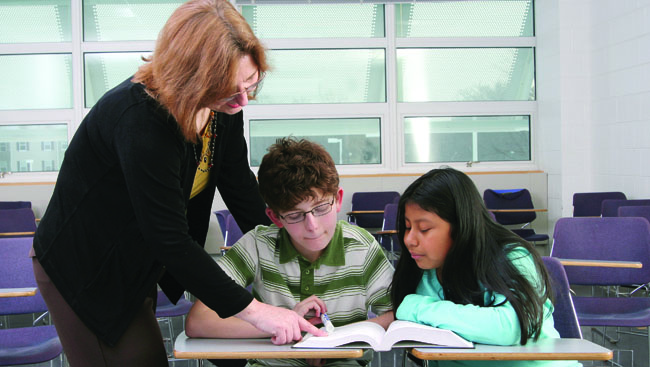Neuroeducation
- Published23 Oct 2010
- Reviewed23 Oct 2010
- Source BrainFacts/SfN
Educators and scientists have long known that teaching, learning, and brain function are intricately connected. But until recently, the fields of education and neuroscience have remained isolated in the classroom and lab, respectively, with only sporadic attempts to find opportunities for strategic cooperation. Public interest in how these areas can benefit each other has grown in recent years, and the conversation between educators and researchers is starting to gain momentum.

Scientists and educators are exploring how to apply research on learning and development to improve teaching methods and curricula.
Copyright 2010, Photo by Matt Antonino/Shutterstock.com
Participants are excited about applications for both the education and scientific communities and are encouraging open communication to explore new possibilities. In 2009, this groundswell of interest in neuroeducation led Thomas J. Carew, then president of SfN, to convene the Neuroscience Research in Education Summit at the University of California, Irvine. Researchers, teachers, and policymakers participated in the event and helped to further develop recommendations for encouraging educator/scientist collaboration.
Neuroeducation: What Is It?
The collaboration between educators and neuroscientists has taken the form of an emerging discipline known as neuroeducation. This developing field blends the collective specialties of neuroscience, psychology, cognitive science, and education to improve teaching methods and curricula. Understanding how neuroscience can inform education strategies and finding out what teachers want and need to know about the ways students learn are two key drivers behind the neuroeducation initiative.
Many areas of neuroscience are already producing research findings that could provide ideas to improve teaching methods and curricula. Studies of memory formation and retrieval suggest testing is important for learning. The inclusion of the arts, particularly music, can enhance memory and attention levels, according to recent research. Also, multiple studies investigating the impact of sleep and exercise on young brains indicate the importance of these activities in brain development, function, and health. Integrating this research into classroom practice, however, will require meaningful dialogue between educators, scientists, and policymakers to adequately inform both research agendas and teaching practices.
A Developing Partnership
Several universities have taken the lead to effectively bridge the gap between neuroscience and education. The Neuro-Education Initiative at Johns Hopkins University aims to bring educators and scientists together through the development of joint research projects to improve the understanding of how students learn and develop. Harvard University’s degree program in Mind, Brain, and Education allows participants to explore the intersection of biological neuroscience and education.
These programs and efforts like the SfN summit have collectively identified several goals that could encourage progress within the neuroeducation movement. For example, moving beyond each field’s institutionalized jargon to create a shared vocabulary is an important first step in bridging the communication gap between education and neuroscience. Identifying core research priorities also has become increasingly critical for shaping the field’s future agenda, as has securing tangible financial resources to successfully ensure continued progress.
Looking to the Future
Educators and scientists must continue to improve collaboration and keep communication open, topical, and research-driven to ensure effective progress. The continued popularity and proliferation of “neuromyths” show that misguided notions about the brain have far-reaching influence on curriculum development, and the neuroscience community is working diligently to correct those inaccuracies. Reaching teachers in preparation programs and those already in practice to effectively improve their awareness of current findings in brain research remains a paramount concern. Strategies for developing opportunities to promote the interaction of teachers and scientists in labs and as mentors to each other also offer exciting possibilities for bringing neuroscience and education together.
Continued efforts will be necessary to ensure scientific research on learning and childhood health and development is made relevant and understandable to educators and parents.
This is an important first step in a strategic agenda for the fields of both neuroscience and education to make neuroeducation a paradigm for informing broader social and educational policies. Improving academic achievement and scientific literacy through the education-neuroscience partnership promises better opportunities for young people and society-at-large.
CONTENT PROVIDED BY
BrainFacts/SfN
Also In Archives
Trending
Popular articles on BrainFacts.org

















